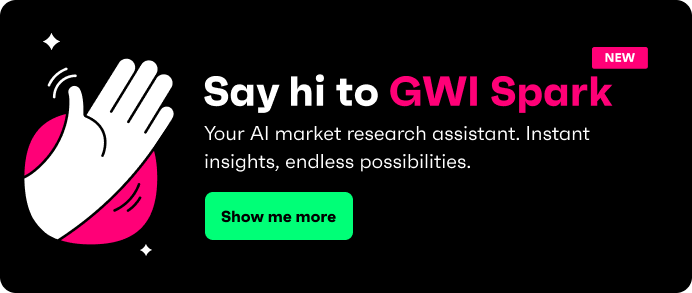
A strong marketing strategy turns good businesses into exceptional ones. Take Nike, for example. They use detailed consumer insights to create campaigns that tap into athletes’ passions and lifestyles. When your strategy is guided by real audience data, every message hits home, making your campaigns more authentic and effective.
What is a marketing strategy?
A marketing strategy outlines how your company will achieve specific business goals through targeted marketing actions.
It’s more than just a marketing plan or a checklist of promotions. A solid strategy pinpoints who your target customers really are, what matters to them, how you’ll reach them, and how you’ll know if you’re succeeding.
It’s the long-term game plan that sets your business up to win in a crowded market.
Why does a strong marketing strategy matter?
Companies with clear marketing strategies consistently outperform their competitors.
For example, McKinsey found companies with these clear strategies achieve around 25% higher ROI and stronger customer loyalty. That’s because their marketing is tied directly to big-picture goals like growing market share or boosting retention. Without a solid strategy, even great marketing can miss the mark, wasting budget and leaving opportunities on the table.
The core components of a winning marketing strategy
An effective marketing strategy is built around some essential components.
Understanding and then mastering these will help make sure your marketing activities deliver consistently. Let’s take a look at what makes a winning market strategy:
Clear business goals and objectives
Clear business goals give your marketing strategy direction.
Whether it’s building brand awareness, growing market share, or driving sales, every activity should serve a specific purpose. And those goals need to be measurable. You need to be able to track progress, see what’s working, and adjust as needed. Sounds simple, right?
Deep understanding of your target audience
Knowing your audience on a deeper level helps your marketing resonate.
Think about Patagonia (the brand, not the region in Argentina). They don’t just sell outdoor gear; they understand their customers’ passion for environmental causes and adventure. Platforms like GWI help marketers uncover these deeper behaviors, interests, and motivations, so your marketing speaks directly to what drives your audience.
When you get this right, engagement and results naturally improve. Bingo.
Competitive analysis and market positioning
A thorough analysis of your competitors gives your marketing clarity and purpose. You need to be recognizing where your brand can differentiate itself.
Clearly positioning your brand in the marketplace helps your audience understand exactly what sets you apart, making your marketing more memorable and effective.
Content and messaging strategy
Strong content hits the mark because it’s built on real insight.
Take Glossier. Their marketing speaks directly to millennial beauty fans by focusing on authentic stories and real skin issues, and that all-important ‘millenial pink’ packaging.. When your messaging and brand is grounded in what your audience cares about, your campaigns resonate and deliver better engagement and results.
Effective measurement and optimization
Measurement is critical to a strong marketing strategy.
Monitoring how your campaigns perform, tracking KPIs, and analyzing results regularly help your strategy stay on track (and we’ve all felt that fear when it goes off-track). Using real-time, consented consumer data keeps your strategy responsive to changes in the market, or shifts in customer behavior.
How to use consumer insights to strengthen your marketing strategy
Consumer insights inform every step of an effective marketing strategy, giving you the knowledge you need to make confident decisions. They’re your secret weapon, if you like.
Audience segmentation: Know exactly who you’re targeting
Effective marketing strategies rely on precise audience segmentation. Brands like Airbnb use detailed segments to target specific traveler types: from families seeking adventure, to solo urban explorers. Tools like GWI help you drill down into lifestyles and attitudes so your campaigns hit the right people with messages that resonate.
Data-driven content strategies that convert
When you use consumer data to shape your content strategy, your messaging matches perfectly with audience interests. Using real consumer data to guide your content (fingers crossed) means higher engagement and measurable conversions.
Real-time insights for agile marketing decisions
Real-time insights empower marketers to act quickly and stay competitive. When TikTok trends shift overnight, brands using real-time data can pivot instantly.
Access to up-to-the-minute consumer insights lets you keep campaigns relevant and avoid wasting budget on outdated strategies.
Enhancing your marketing strategy with GWI’s consumer data platform
The GWI platform integrates seamlessly into your marketing strategy, adding value at every stage. It provides quick, actionable insights so you can make strategic decisions confidently.
Leveraging dashboards and charts for quick insights
Visual tools such as GWI’s Dashboards and Charts simplify complex consumer data.
You can quickly identify trends, spot opportunities, and share insights across teams. This immediate understanding speeds up decision-making, giving your marketing strategy greater agility.
API integration: Seamless access to insights
GWI fits right into your existing workflow, giving you fast, actionable insights whenever you need them. Whether you’re planning a campaign or tweaking messaging, GWI helps you make confident, informed decisions.
Crosstabs: Advanced audience understanding
GWI’s Crosstabs feature helps marketers uncover deeper audience insights by cross-analyzing different data points. Crosstabs let you connect the dots between data points, like discovering that your eco-conscious shoppers also prefer online-only brands. These insights help you tailor messaging so your campaigns feel custom-made and hit the mark every time
Marketing strategy in action: Real-world use cases
Great strategies don’t just sound good on paper. They deliver real results. Here are real stories of brands using insights to tackle challenges and win big in competitive markets.
Agency pitching and media planning
Agencies win pitches by showing deep audience understanding.
Picture one pitching to a luxury skincare brand targeting eco-conscious consumers. Using GWI insights, the agency highlights lifestyle habits, buying triggers, and preferred channels, making their pitch laser-focused.
This data-backed precision wins the client’s trust and leads to more effective media plans that deliver results.
Content strategy and audience engagement
Brands that use real data outperform guesswork.
Take a global fashion retailer facing dropping social engagement. Consumer insights revealed their audience loves short videos on sustainability, so they pivoted to quick clips about ethical sourcing and eco-friendly tips.
Engagement shot up, showing how content aligned with audience values drives real impact.
Sponsorship and partnership alignment
Big sponsorships come with big risks, that is, unless you know your audience well.
For instance, a beverage company debating between a music festival or esports sponsorship found, through GWI data, that their consumers preferred esports.
Betting on esports paid off with stronger brand awareness and loyalty, turning insight into a smart investment.
Best practices for developing a powerful marketing strategy
Building a marketing strategy that works isn’t just about planning; it’s about consistently applying a few key best practices. Here is some advice from us to you:
Start with clear goals
Every effective marketing strategy begins with goals closely tied to your broader business objectives. Clear goals are the very foundation. Take a tech startup breaking into a crowded market: by setting measurable user-growth targets, they focus every marketing move on hitting those milestones instead of vague hopes.
This focus drives real progress.
Keep your audience at the core
Your audience should always lead the way. When a financial services firm saw younger investors seeking simpler options, they didn’t guess: they used insights to create targeted messaging and products, boosting engagement and revenue in the process.
Regularly evaluate and adjust
Things change fast, so your strategy should too. For example, a retailer seeing fewer store visits noticed a shift toward online shopping through regular insights.
By quickly adapting their marketing to focus on digital, they reversed declining sales and found new growth.
Final takeaway: Great marketing strategies start with insights
The best marketing strategies understand. By leaning on clear, actionable insights about your audience’s values and behavior, and tools like GWI, you keep your strategy relevant and effective. When you base decisions on real data, your marketing stops hoping to succeed…it delivers.
Frequently asked questions about marketing strategies
What is a marketing strategy?
A marketing strategy is a detailed, long-term approach designed to achieve specific business goals. It clearly defines your target audience, positions your brand competitively, guides your messaging, and includes measurable criteria for success. Essentially, it’s your roadmap to reaching your business objectives.
How do you create a marketing strategy?
Creating a strategy involves defining clear business objectives, deeply understanding your target audience through consumer insights, analyzing your competitors, crafting targeted messaging and tactics, and consistently measuring performance. It’s a systematic approach ensuring every marketing action contributes meaningfully to your goals.
Why is consumer insight important in marketing strategies?
Consumer insights ensure your marketing strategy resonates with the actual preferences and behaviors of your audience. They provide clarity and direction, reduce risk, and significantly improve the effectiveness of your campaigns. Simply put, insights make your marketing smarter and your ROI stronger.





.webp?width=495&height=317&name=pink_thumb_graphs%20(1).webp)
.webp?width=495&height=317&name=pink_thumb_letter%20(2).webp)